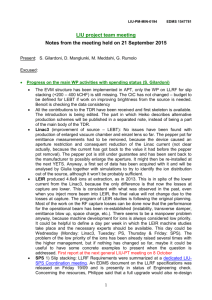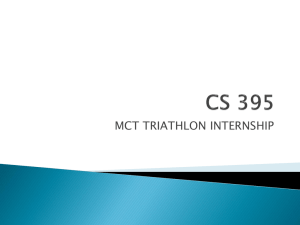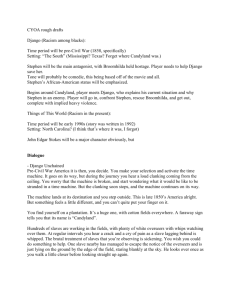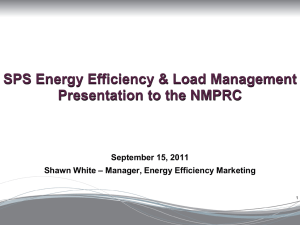minutes_011013
advertisement
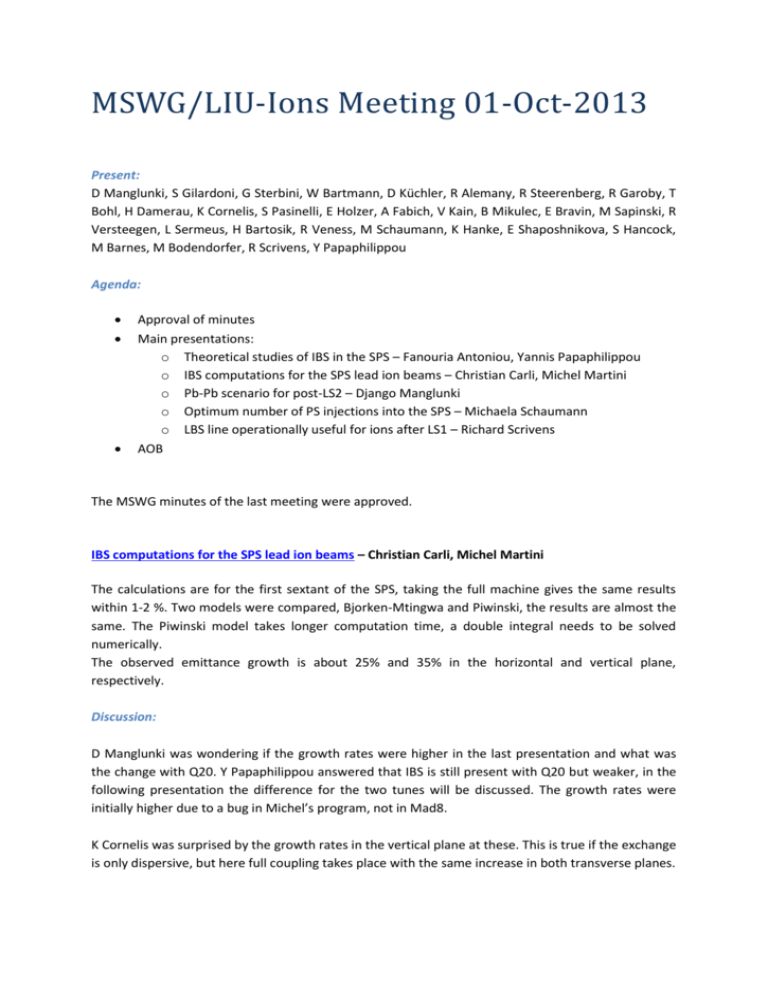
MSWG/LIU-Ions Meeting 01-Oct-2013 Present: D Manglunki, S Gilardoni, G Sterbini, W Bartmann, D Küchler, R Alemany, R Steerenberg, R Garoby, T Bohl, H Damerau, K Cornelis, S Pasinelli, E Holzer, A Fabich, V Kain, B Mikulec, E Bravin, M Sapinski, R Versteegen, L Sermeus, H Bartosik, R Veness, M Schaumann, K Hanke, E Shaposhnikova, S Hancock, M Barnes, M Bodendorfer, R Scrivens, Y Papaphilippou Agenda: Approval of minutes Main presentations: o Theoretical studies of IBS in the SPS – Fanouria Antoniou, Yannis Papaphilippou o IBS computations for the SPS lead ion beams – Christian Carli, Michel Martini o Pb-Pb scenario for post-LS2 – Django Manglunki o Optimum number of PS injections into the SPS – Michaela Schaumann o LBS line operationally useful for ions after LS1 – Richard Scrivens AOB The MSWG minutes of the last meeting were approved. IBS computations for the SPS lead ion beams – Christian Carli, Michel Martini The calculations are for the first sextant of the SPS, taking the full machine gives the same results within 1-2 %. Two models were compared, Bjorken-Mtingwa and Piwinski, the results are almost the same. The Piwinski model takes longer computation time, a double integral needs to be solved numerically. The observed emittance growth is about 25% and 35% in the horizontal and vertical plane, respectively. Discussion: D Manglunki was wondering if the growth rates were higher in the last presentation and what was the change with Q20. Y Papaphilippou answered that IBS is still present with Q20 but weaker, in the following presentation the difference for the two tunes will be discussed. The growth rates were initially higher due to a bug in Michel’s program, not in Mad8. K Cornelis was surprised by the growth rates in the vertical plane at these. This is true if the exchange is only dispersive, but here full coupling takes place with the same increase in both transverse planes. The beam size evolution along the train helps, in particular for Q20 the horizontal beam size is much larger and thus scattering is reduced. Also the initial vertical emittance is smaller. These theoretical results agree with what is observed in the machine. Concerning different growth rates in the models and measurements, the models assume Gaussian beams while the distribution in the longitudinal plane is rather uniform and this should bring the growth rates down. One could reactivate an existing code to take into account the distribution and benchmark with measurements from the longitudinal plane. V Kain commented that in LHC no effect is seen on the longitudinal plane. KC answered that the longitudinal momentum exchange is relativistic; in LHC relativistic gamma is much higher and beam sizes smaller. Theoretical studies of IBS in the SPS – Fanouria Antoniou, Yannis Papaphilippou Motivation of the study was the dispersion of lead beam parameters at SPS flat top; as cause a combination of RF noise, IBS and space charge (SC) was suspected. The Bjorken-Mtingwa model was implemented in Madx and cross-checked, it delivers correct results but using “RF on” should be done with caution. Results for different tunes: Larger beam sizes with Q20 give a 15% reduction of IBS in both planes. Comparison with measurements shows that the bunch length reduction is stronger than expected while there is no blow-up in the transverse planes. A Touschek(-like) effect with a quadratic lifetime decay could explain this behaviour. Large angle scattering knocks out particles off the bucket and causes losses but the emittance is barely affected. To estimate the lifetime a general quadratic form of the current decay is assumed with also other effects than multiple scattering like RF noise. The non-relativistic round beam approach is not directly applicable for our case of non-Gaussian beams and a filled bucket. For higher energies the Touschek effect becomes more negligible. Calculating the Touschek contribution to the lifetime decay shows a factor 2 larger value for Q26 than for Q20 due to bigger beam sizes. If the lifetime limit is dominated by the Touschek effect, lifetimes will be better for Q20. The SC tune shift is reduced by about 10% for Q20. Assuming the same RF acceptance, Q20 is almost independent from the linear term (b factor) and dominated by the quadratic Touschek term. MD data with FT tune: the working point is optimised for slow extraction above half integer and not for the LHC working point which is optimal for SC; best transmission was observed for lower voltage with a rather parabolic and not anymore exponential lifetime decay. So the lifetime is SC dominated without Touschek behaviour. Since the WP was moved close to the integer the beam was blown up by a factor 3; resulted in better transmission but lost brightness, so not much gain. Request of measurements on SPS flat bottom for different working points. Discussion: E Shaposhnikova was asking why the same longitudinal emittance was assumed for both tunes –the slippage factor is about the same for ions, thus the effect not so big. R Alemany was asking what the difference was in the two tunes since the linear term contained everything else than the Touschek effect and for Q20 the lifetime does not depend anymore on the linear term. RF noise should be the same for both tunes. IBS and SC are reduced for Q20, so the linear term has much less role; what is remaining is the quadratic (Touschek) term but this includes many hypotheses. One can’t say which lifetime is to be expected for a certain current from this model, only relative behaviours. It would be beneficial to get a multiple particle code working. K Cornelis was asking concerning the measured bunch shortening (slide 7) where the shrinking is not explained by IBS. RF noise can be the cause of bunch shortening, like a longitudinal scraping where particles are lost. The bunch shape in the longitudinal plane is not necessarily affected. T Bohl commented that this behaviour was also observed in the ISR for protons. M Sapinski was asking whether the transverse emittance measurements need to be bunch-by-bunch – need measurements for a single bunch, bunch-by bunch capability would speed up the measurement though. Pb-Pb scenario for post-LS2 – Django Manglunki Wolfgang Bartmann asks what effect the change from 50ns to 75ns has on the filling time. Django replies that the longer this time interval, the longer the SPS train, the smaller the number of trains fitting into the SPS and the shorter the filling time. But all of this at the expense of having fewer bunches in the machine. Richard asks whether the presented scenario assumes an improved ion performance from the source, Linac3 and LEIR. Django replies that the presented scenario demands an intensity 40% higher per bunch out of LEIR than achieved in 2013. Roland asks how much does the Luminosity change in LHC. Django replies by a slide showing the intensity vs. injection kicker rise time. He proposes four bunches out of PS, spaced by 50ns, with an injection overhead of 75ns. Roland asks about the scenario where the splitting into four bunches in the PS would not be successful and where only two bunches would be available instead. Django replies that this scenario is represented by the orange dots on his slide. This would result in fewer bunches and a longer filling time. Django continues by stating that the bunches also suffer at flat bottom of LHC. Michaela adds that the plots shown in her presentation will take into account how much time the injection takes, whereas Django’s plots don’t. Richard cautions that there is no existing scheme, of how to achieve 40% more intensity out of LEIR or Linac3 compared to the last achieved values before LS1. Django replies that we are still in the process of understanding the low energy loss in the LEIR machine. He states that we need about 40% more out of LEIR and that there are several options of achieving this goal, such as a 10Hz injection scheme and mitigating the lower energy loss in LEIR. Optimum number of PS injections into the SPS – Michaela Schaumann Django states that his simulations overall agree with Michaela’s simulations. He adds that, if the decay time changes a little, this would have a large effect on the optimal number of injections. Furthermore if we improved the situation on the flat bottom, especially with a reduction of RF noise, then he expects the optimal number of injections to, again, change a lot. Reine asks with respect to Michaela’s slide 16, about the number of injections beyond 12 to shorten the filling time, lowering the flat bottom loss in LHC and, hence, increase integrated luminosity. Karel cautions that more injections come with a larger risk of failure of one or multiple injections from the previous injector machines, reducing the chance of a successful train. Roland suggests considering the integrated luminosity over one hour instead of integrated luminosity per fill. Karel cautions for a higher likely of an SPS cycle going wrong with a higher number of bunches in the SPS. Roland asks of how far or close the performance of the ion injectors are from the expectations of the ALICE detector. Michaela has estimated with the proposed 50/75ns scenario to achieve 1.3nb-1 for one ion run after LS2. Django adds that ALICE expects 10nb-1 in total after LS2, which would thus need 7 or 8 runs. Karel suspects that with a bunch spacing of 50ns, the performance of the whole LHC injector chain would become more sensitive to the performance of LEIR and Linac3 than it was before LS1. Reyes states that last year the performance was limited by the BPM in IR point 6 and the intensity of the bunches. Michaela replies that this is true but only for the proton-lead run because of fast decay by burn off of ions by protons. She adds that this is not expected to have such a strong impact on a lead-lead run. Reine adds that those problems are under investigation right now by BI and that there should already be an improvement after LS1. LBS line operationally useful for ions after LS1 – Richard Scrivens Django thinks that the Schottky measurement in LEIR is complimentary to the spectrometer line after Linac3 and not replacing it. Roland would like the question answered whether LIU needs the proposed consolidation of the Linac3 spectrometer line? Richards replies that it is necessary. Roland would also like the question answered whether LIU is the only project, which would need the proposed consolidation, and whether or not Medical-Ions would also need it. He adds that in the future, the medical use will be dominant time wise. Django replies that only LIU needs the fine measurement; for medical or fixed target a coarse resolution is good enough. Roland says that the proposed consolidation can be considered if it can be demonstrated to be necessary and, that, if other projects need it then the cost should be shared. He also thinks that it is legitimate to produce a study. Bettina adds that the potential upgrade of the LBS line should fit into the time line of Linac4-toBooster-connection schedule. She strongly supports Richards proposal to remove the LBS line from the booster infrastructure in order to relieve the booster operation from the time consuming setup procedure of the LBS line startup. Rolands asks whether there is already an idea of where to put the new, proposed spectrometer line. Richard replies that a few meters after the wall, there would be enough space for it. Karel states that answering these questions represents an action item. Roland asks whether other means of measurement are interesting to determine the momentum distribution of the ion beam, such as a time-of-flight measurement and that the proposed consolidation is not necessarily resulting in a spectrometer. Richard replies that a time-of-flight measurement is not efficient to measure the momentum distribution of an ion beam. He adds that a spectrometer line is the most simple and straightforward solution for this kind of measurement. AOB: Next meeting: 19-November-2013
